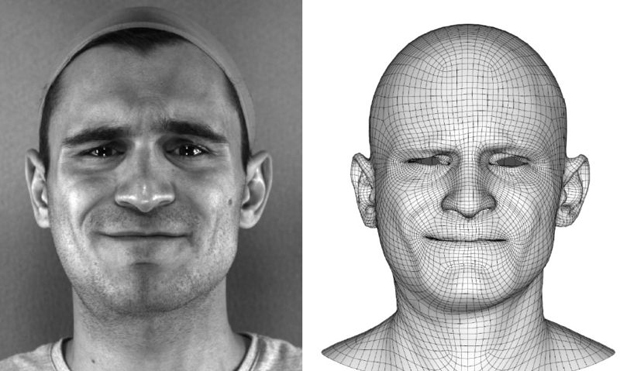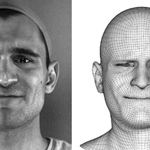Adobe Research has built on its Project StyLit experiments to develop a new project called “Stylized Facial Animation” — a tool for automating rotoscopy which can apply any selected artistic style, from a pastel sketch to a bronze statue, onto video footage of actors’ faces. Adobe will hold a public demo of the technology on Thursday, August 3 at SIGGRAPH, or you can read up on the project in Digital Trends’ interview with Senior Principal Scientist David Simons.

Following its presentation at Tuesday’s “Open Source at Pixar: USD and OpenSubdiv” Exhibitor Session, Animal Logic has launched its USDMaya plugin (known as “AL_USDMaya”) as an open source tool. The plugin enables powerful and efficient authoring and editing of 3D graphics data using Pixar’s open source Universal Scene Description (USD) in Autodesk’s Maya. The aim is to leverage the strengths of both Maya and USD, and use each one to represent the data it’s most suited to.
Animal Logic uses AL_USDMaya to allow native Maya entities such as complex Maya Rigs loaded as references, and other assets not easily represented in USD, to be embedded in USD scenes and imported into Maya in their native form. The plugin maintains a “live” connection between the USD and Maya scene, and can respond to various events, keeping the Maya and USD scenes in sync. This affords a dynamic user experience that allows artists to swap in and out different representations of objects in their scene, including Rigs for geometry caches and different levels of detail. Additionally, heavyweight scene elements such as sets and crowds can be represented in OpenGL in the Maya viewport, and manipulated either with USD or Maya tools and UI components. The source code is available now.
Fabric Software (www.fabricengine.com) introduced Fabric Engine 2.6, with key advancements for VFX, games and VR studios. The update is available in August for existing customers.
+ Asset Patterns offer a rules-based way to control data flow to and from many different industry formats with support for change propagation – so modeling and other asset modifications made in an authoring application can be quickly pushed to game engines like Unity and Unreal without a full import process.
+ Manipulation Framework lets technical directors and developers tailor the user experience of using Fabric to create applications and animation rigs that work anywhere in a production pipeline without being limited to what is available in DCC applications like Maya.
+ Rigging Enhancements, including support for the Autodesk’s newly open-sourced AnimX curve library; and a new RBF (Radial Basis Function) solver ideal for pose-based deformations that need to be solved in real-time, such as facial animation or secondary animation of cloth over a muscle system.
+ Universal Scene Description Support, tapping in to Pixar’s open-source USD library for handling vast, complex scenes. “We believe that USD could be a key technology for real-time applications used for visualization, VR and AR,” says Fabric Software CEO Paul Doyle. “There is no industry standard yet for how we store and work interactively with data at scale. Customers are telling us that USD might be it. With our new Asset Patterns functionality, we see Fabric Engine as an enabling technology for USD that could accelerate adoption and help developers standardize their pipelines.”
NVIDIA and game developer Remedy (Alan Wake, Quantum Break) showcased their team-up solution to streamlining motion capture and animation using a deep learning neural network, running on NVIDIA’s powerful DGX-1 server. After being “trained” with information on previously produced animations, the network is able to generate sophisticated 3D facial animation from videos of live actors, greatly alleviating the time and labor burden of traditional mo-cap animation — it can even learn enough to generate facial animation from just an audio clip. The companies believe this system could eventually produce animation that’s just as good or better than traditionally produced fare.
“Based on the Nvidia Research work we’ve seen in AI-driven facial animation, we’re convinced AI will revolutionise content creation,” said Antti Herva, lead character technical artist at Remedy. “Complex facial animation for digital doubles like that in Quantum Break can take several man-years to create. After working with Nvidia to build video- and audio-driven deep neural networks for facial animation, we can reduce that time by 80% in large scale projects and free our artists to focus on other tasks.”

Attendees should seek out the Pavillon France to meet the companies selected by Cap Digital and Imaginove to represent the finest in French tech and innovation. The 16 exhibitors in the 24-company contingent are seeking to connect with major players from around the world, with the support of the CNC: Eisko (www.eisko.com) – specializing in 3D celeb representations for VFX and interactive; 4DViews (http://4dviews.fr) – dynamic volumetric capture system; Dynamixyz (www.dynamixyz.com) – facial performance capture software; SPARTE (https://sparte.io) – solutions for VR, 3D printing, etc.; Stimergy (www.stimergy.com) – green energy render farm rental; Ranch Computing (www.ranchcomputing.com/en) – render farm & 3D modeling/calculation services; Qarnot Computing (www.qarnot-computing.com/fr) – fully-featured green render farm as a cloud of home heaters; Persistant Studios (www.persistant.ca) – PopcornFX real-time 3D particle effects middleware; Mercenaries Engineering (www.guerillarender.com) – 3D software for animation & VFX, Guerilla Render; Golaem (http://golaem.com) – crowd simulation, layout & previz tools; Texels (www.texels.com) – Kurtis pipeline creation and automation software for animation & VFX; Mikros Image (www.mikrosimage.eu) – post-production for animation, feature films & commercials; TVPaint Animation (www.tvpaint.com) – bitmap-based 2D software; Composite Films (www.compositefilms.fr) – Film restoration/colorization; Kolor (Gopro division) (www.kolor.com) – software solutions for immersive experiences; and Speedernet-Sphere (www.speedernet.com) – software for 260 and VR experiences for web.





 Win a Funko X Lilo & Stitch Prize Pack!
Win a Funko X Lilo & Stitch Prize Pack! 